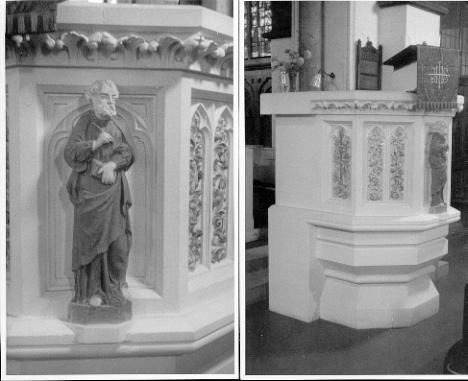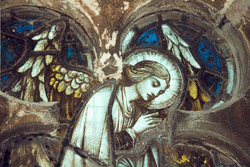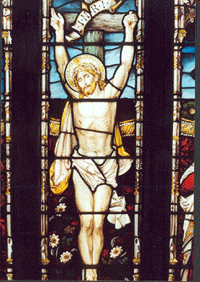

|
A
History of the Parish Church of St Matthew,
Kingston upon Hull, North Humberside, England: |
|
|
The Church was built in 1870, in response to the rapid expansion of the township, now City of Kingston upon Hull. Previously the people of Hull had lived in a tight community around its two medieval churches of Holy Trinity and St Mary's, Lowgate. During the population explosion of the mid-Victorian period it was necessary to build on the surrounding farm lands. St Matthew's was built on such a site, approximately 2 miles from the town centre on the road to Anlaby and beyond. The Rev'd George Robinson, Curate of Holy Trinity, was charged with the task of creating the new parish in 1867. |

The original pulpit at St.Matthew's with statue of our Patron
Saint.
This was removed in 1970 and replaced with the wooden pulpit from the former
church of St.Barnabas
|
A most gracious spire was to adorn the north-eastern corner of the church, offering a new landmark to people of Hull. Today, this spire remains such a signal feature, the tallest spire in the city and visible from far and wide. The church was consecrated by Archbishop Thompson of York on St Luke's Day, 18th October, 1870. For some unknown reason it was dedicated to neither St Luke or St Michael, taking the name of St Matthew. The Rev'd George
Robinson remained with the new Parish as its first Incumbent until 1907, an extremely long and faithful ministry. During that time
the Parish was established as probably the premier residential community
of Hull. To the Church were quickly added the very best of fixtures and refinements. An organ
was installed in 1877, built by the well known firm of Foster & Andrews. |

Detail from window in the Remembrance Chapel
|
In the year of our Centenary the neighbouring Parish Church of St Barnabas was closed down and amalgamated with St Matthew's. The congregation of St Barnabas joined their new home and brought a number of fittings from their former church. Hence the pulpit and choir stalls in the church today are those coming from St Barnabas, rather than the original but less appreciated ones of St Matthew's. The Value & Importance of St Matthew's today: Although the
Victorian age saw many Church buildings added
to this community, both for the Church of England
and the Free Churches, most of these have not stood the test of time. St Matthew's is now one of just three Victorian built
Anglican Churches left in the city. The
others are those of St John's, Newington and St Giles' Marfleet. Of the three St Matthew's
is by far the most important to the surviving architectural heritage.
Whilst both St John's and St
Giles' are churches hidden
away from all but immediate view, St Matthew's, alone is surmounted by a spire and stands alongside
one of the major roads into the City
and also the mainline raiIway. |

Crucifixion panel from the East window
|
We seek to
serve the Parish community through our ongoing provision of uniformed youth work. Our
Parish Hall is home to the excellent Wellington-St Matthew's Scout group (Beavers, Cub scouts, Scouts & Venture Scouts) and our
church sponsored Brownies. Additionally we provide a home for The Dagger
Lane Operatic Society, the Victoria Players (a music hall company) and
a keep fit group. |